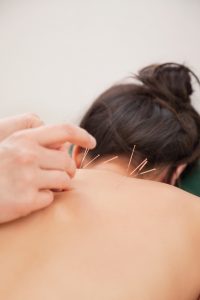Fibromyalgia and Pain: Natural Treatments
According to the American Chronic Pain Association, fibromyalgia is a medically unexplained syndrome characterized by chronic widespread pain and a heightened and painful response to pressure (allodynia). Fibromyalgia (fī'brō-mī-āl'jē-ə) affects more than 6 million people in this country. Most of them are women, but it does occur in men as well. Other core symptoms are debilitating fatigue, sleep disturbance, and joint stiffness. Some patients may also report difficulty with swallowing, bowel and bladder abnormalities, numbness and tingling (paresthesia) and cognitive dysfunction.
Fibromyalgia is a term that's been used only fairly recently. It is not a new condition. Previous to this, it was referred to as soft tissue rheumatism or fibrositis or non-articular rheumatism.
People with fibromyalgia may experience the following symptoms:
➮ Wide- Spread Aches and Pains
➮ Localized pain in the neck area
➮ Pain in the rib area
➮ Lower back pain
➮ Chronic Fatigue
➮ Tension Headaches
➮ Myofascial Pain Syndrome (means pain and inflammation in the body's soft tissues)
➮ Tender points in the thigh area
➮ Immune Deficiency Syndrome
➮ Depression
➮ Lethargy
➮ Sleep Disruption Problems
➮ IBS and related digestive problems
➮ Problems with concentration
➮ Irritability
➮ Anxieties
➮ Vulvar pain syndrome
➮ Nails and hair brittle and poor quality
➮ Weight gain
➮ Sugar cravings and a form of hypoglycemia
Many people live with pain for years before fibromyalgia is found as the cause. A recent brain-scan study confirms scientifically what fibromyalgia patients have been telling a skeptical medical community for years: They're really in pain.
In fact, the study finds, people with fibromyalgia say they feel severe pain, and have measurable pain signals in their brains, from a gentle finger squeeze that barely feels unpleasant to people without the disease. The squeeze's force must be doubled to cause healthy people to feel the same level of pain—and their pain signals show up in different brain areas.
The results, published in the May issue of Arthritis & Rheumatism, the journal of the American College of Rheumatology, may offer the proof of fibromyalgia's physical roots that many doubtful physicians have sought. It may also open doors for further research on the still-unknown causes of the disease, which affects more than 2 percent of Americans, mainly women.
Now, more healthcare providers are aware of the condition. This means that it can be addressed sooner. And there is a growing list of treatments that may help.
According to sources such as the National Institutes of Health, American Medical Association, and American College of Rheumatology, little is known about the cause of this type of pain, but the central nervous system does play a role. Unfortunately for this progressive disease, there is no cure for fibromyalgia but there are treatments that can help. Many people have found ways to have a good quality of life in spite of fibromyalgia.
The following are ways to live a more comfortable life with fibromyalgia:
➲ Plenty of sleep
Nap any time that you can.
➲ Move your body
Keep active-walking and low impact sports are great examples.
Meditation helps tremendously. This allows you to separate the mind from the pain
➲ Magnesium and Malic Acid supplements
Consult the doctor or a nutritionist to have your Magnesium level checked. It is a simple painless mouth swab
➲ Epson Salt baths
Take 2-3 warm Epson Salt baths a week (Epson salt contains Magnesium and soaking in a warm tub helps the body to absorb the mineral into the body better. Magnesium aids the muscles in better utilization of oxygen. When body magnesium levels are low, cramps, spasms, and pain may augment.)
➲ Eliminate Sugar from your diet.
No more sugar–sweets, candies, syrups, etc. Instead, use Xylitol 'from birch bark' - sweet with no bitter aftertaste. Xylitol can also help prevent tooth decay. Instead of adding sugar or artificial sweetener to your beverages or food, use Liquid Stevia. Do not use any artificial sweeteners.
More traditionally, Neurologists, Rheumatologists, Chiropractors, Psychiatrists, and pain specialists will address the symptoms of fibromyalgia and focus on the pain aspect in terms of medications. Solutions such as massage, muscle relaxants trigger point injections, nerve blocks, steroid shots and braces as well as surgeries are most popular. More progressive treatments include biofeedback and acupuncture.
❖ Massage Therapy
Massage therapy is another alternative pain treatment that is one of the most commonly tried for fibromyalgia. The benefits of massage are hard to demonstrate in a clinical study, but it does seem to be helpful for many types of muscle pain, including fibromyalgia. Massage is generally safe. It may certainly relieve tightness and promote relaxation, but it is not likely to provide any long-term fibromyalgia help.
❖ SAM-e
This is a great item for natural joint support and mobility, AND for emotional wellness. This very important supplement is backed by over 20 years of research. It helps to support positive mood balance, joint and liver function. SAM-e is found naturally in every cell in the human body and increases levels of important neurotransmitters such as serotonin and dopamine. It also protects the liver from fat infiltration.
❖ Co-Q-10
Research indicates that CoQ10 may support heart health by supporting cellular energy production.
❖ Beta Glucans, with ImmunEnhancer
Beta Glucans gives your body a very powerful nutritional boost for natural cellular defenses. Beta Glucans activates NK cells and is helpful to the immune system and against tumors. For a stronger immune system, take one Beta Glucan tablet a day.
❖ Liquid Calcium Magnesium
Best used in the morning and right before bedtime. People often need more calcium and magnesium than any other vitamin or mineral because they are the primary building blocks of bones, teeth, and muscles.
❖ Source Naturals L-Lysine
This is an all-natural stress fighter and immune booster. It can help regulate your immune system response - especially when you are under extra stress situations. Take extra L-Lysine when exposed to crowds and during flu season.
❖ Emer’gen-C
This handy packet of 1000 mg of Vitamin C and 25 different electrolytes in the ascorbic acid form delivers 8 times more potassium than Gatorade and other sports drinks. When you add water to the Emer'gen-C powder, it immediately effervesces to a powerful, delicious, and healthful activator of your metabolic functions.
❖ Glucosamine Chondroitin plus MSM
This helps with inflammation. MSM is an excellent source of safe and substantial relief. This helpful relief comes from MSM's pain reducing, anti-inflammatory and increased blood-supply properties. Soft tissue inflammation responds well to minerals which improve blood flow.
❖ Vitamin D
Both vitamin D and magnesium levels have been found to be low in people with fibromyalgia, but as of yet, there is no evidence that taking vitamin supplements are an effective fibromyalgia treatment. Vitamin D, known as the sunshine vitamin, does have some effects on nerve and muscle function, and some studies have suggested that low levels of vitamin D may be associated with chronic pain of fibromyalgia. In a small clinical study published online in the In a recent issue of Pain Medicine, fibromyalgia symptoms improved in 30 women after 8 weeks of vitamin D supplementation. However, other researchers have failed to find any association between fibromyalgia and vitamin D levels.
❖ Acupuncture
Acupuncture is one of the oldest forms of treatment for chronic pain and is based on ancient Chinese medical practices. There have been several studies on the usefulness of acupuncture in fibromyalgia. Three studies support the use of acupuncture combined with a pulsed electric current, a treatment called electroacupuncture.
❖ Capsaicin Application
Capsaicin comes from pepper plants and is considered a natural pain reliever. It’s the active ingredient in a variety of over-the-counter sprays and lotions. When applied to a painful area of the body, it stimulates the release of a body chemical called substance P. As substance P is depleted, the pain sensation seems to decrease. Capsaicin has been used for chronic pain in diabetes, cancer, and cluster headaches. It may also temporarily relieve fibromyalgia pain.
❖ Biofeedback
Biofeedback is an alternative therapy that uses the mind-body connection to help you learn to control your chronic pain with the power of your mind. The feedback may come in the form of muscle tension, skin temperature, or brain wave measurements. Biofeedback is helpful for many painful conditions when it is used along with other therapies.
❖ Melatonin Hormone
Melatonin is a natural hormone found in the body, thought to be involved in promoting sleep. Melatonin in pill form is often used as a sleep aid, but it has also been used for depression, chronic fatigue, and fibromyalgia. The experts say there is not enough evidence to support its use for the chronic pain of fibromyalgia. However, many people do get fibromyalgia help from natural and alternative treatments despite the lack of research support.
Resources: everydayhealth.com, webmd, livestrong.com, naturalnews.com, niams.nih.gov




